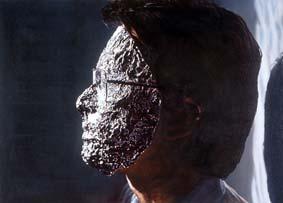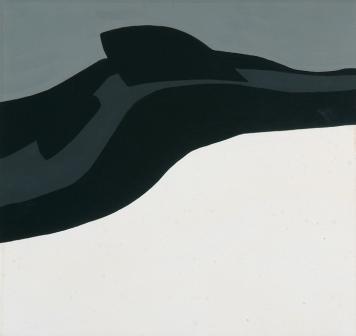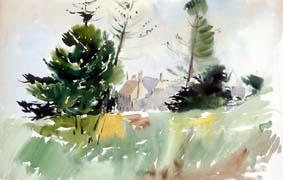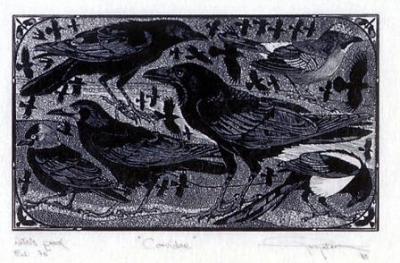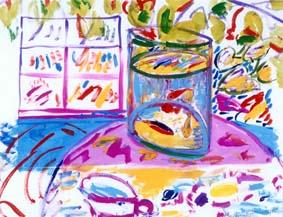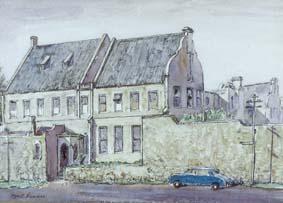(d. Kabuki actors in a street scene)
1847 - 1848Woodblock print, three panels from five panel set depicting Kabuki actors in a street scene. Oban format, lh panel 36 x 24.5, middle panel 36 x 25, rh panel 36 x 24.7.
Originally recorded as Toyokuni, Beach promenade.
Details
Details
Signed 'Toyokuni' at the request of the publisher.
Utagawa Kunisada (1786 – January 12, 1865) stood as a prominent Japanese ukiyo-e artist. Revered as the most esteemed, prolific, and commercially successful designer of woodblock prints in 19th-century Japan, Kunisada's influence transcended that of his contemporaries, including Hokusai, Hiroshige, and Kuniyoshi, garnering him unparalleled renown during his lifetime.
Although much about Kunisada's life remains shrouded in mystery, certain key events have been reliably documented. He was born in 1786 in Honjo, an eastern district of Edo. His given name was Sumida Shōgorō IX, also known as Sumida Shōzō. His family owned a small licensed and hereditary ferry-boat service, which provided a modest financial stability allowing him to pursue leisure activities such as painting. His father, a respected amateur poet, passed away the year following Kunisada's birth.
From an early age, Kunisada displayed a remarkable talent for painting and drawing. His skilful sketches caught the attention of Toyokuni, the renowned master of the Utagawa school and a prolific designer of kabuki and actor-portrait prints. Around 1800, or shortly thereafter, Kunisada became an apprentice in Toyokuni I's workshop. In accordance with Japanese tradition, he was bestowed with the official artist name "KUNI-sada," derived from the latter part of Toyokuni's name.
Kunisada's earliest known print dates back to 1807, though full-sized prints began appearing more prominently in 1809–1810. By 1808, he had begun illustrating e-hon (woodblock print illustrated books), rapidly gaining popularity. Referred to as the "star attraction" of the Utagawa school in 1809, he soon rivalled his teacher Toyokuni in the realm of book illustration. Kunisada's talents extended to actor portraits and bijin-ga (pictures of beautiful women), both of which gained him considerable acclaim. By 1813, he had ascended to a prominent position in Edo's artistic sphere, ranked second only to Toyokuni I.
In 1810, Kunisada adopted the studio name "Gototei," a nod to his family's ferry-boat business, which featured prominently in his early works. Subsequently, he utilized the name "Kochoro" from around 1825, particularly on prints unrelated to kabuki. In 1844, he formally adopted his master's name, Toyokuni I, briefly signing as "Kunisada becoming Toyokuni II." However, from 1844-1845 onward, all his prints bore the signature "Toyokuni," often accompanied by other studio names.
Although Kunisada referred to himself as "Toyokuni II," he is commonly recognized as "Toyokuni III." The reasons behind his disregard for Toyoshige, Toyokuni I's legitimate successor, remain uncertain. Towards the end of his life, he began including his age in his print signatures.
Throughout his career, Kunisada remained a pioneering force in the realm of Japanese woodblock prints. Always ahead of his time and attuned to public preferences, he continuously evolved his style, often diverging radically from the stylistic norms set by his peers. His productivity was staggering, with approximately 14,500 distinct designs cataloged, amounting to over 22,500 individual sheets. It is estimated that he actually produced between 20,000 and 25,000 designs in his lifetime.
Following the traditional path of the Utagawa school, Kabuki and actor prints constituted the majority of Kunisada's oeuvre, accounting for about 60% of his designs. However, he was also highly active in bijin-ga prints (depictions of beautiful women), surpassing all his contemporaries in this genre. From 1820 to 1860, he dominated the market for sumo wrestler portraits, and for a considerable period (1835–1850), he held almost exclusive sway over prints related to "The Tale of Genji."
Kunisada's privately commissioned paintings are lesser known but bear comparison to those of other ukiyo-e masters. His work as a book illustrator remains largely unexplored, although he was prolific in this area as well. Notably, his shunga (erotic) prints, though signed only on the title page under the alias "Matahei" due to censorship, appeared in numerous books.
While landscape prints and musha-e (samurai warrior prints) are rare in Kunisada's oeuvre, he focused primarily on actors and women in the latest fashions. His artistry adapted swiftly to changing fashion trends, ensuring a constant demand for new prints to replace outdated ones.
During the mid-1840s and early 1850s, a period of heightened demand for woodblock prints in Japan, Kunisada collaborated with Hiroshige and Kuniyoshi on three major series, driven in part by political motivations to counter intensified censorship regulations. Additionally, from the mid-1850s, some series featured individual parts or complete sheets signed by Kunisada's students, aiming to promote their work as independent artists. Notable pupils included Toyohara Kunichika, Utagawa Sadahide, and Utagawa Kunisada II.
Kunisada passed away on the 15th day of the 12th month of the First Year of Genji, which in the Gregorian calendar corresponds to January 12, 1865. He died in the same neighbourhood where he was born, leaving behind a legacy of artistic brilliance.
